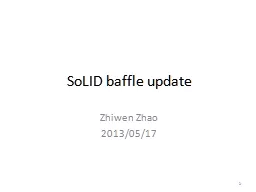

baffle update Zhiwen Zhao 20130517 1 Babar magnet and Babar baffle It is in the original proposal and preCDR The label is wrong It should be 50uA 85 polarized 11GeV beam on 40cm LD2 for 120 days ID: 170359
Download Presentation The PPT/PDF document "SoLID" is the property of its rightful owner. Permission is granted to download and print the materials on this web site for personal, non-commercial use only, and to display it on your personal computer provided you do not modify the materials and that you retain all copyright notices contained in the materials. By downloading content from our website, you accept the terms of this agreement.
Slide1
SoLID baffle update
Zhiwen Zhao2013/05/17
1Slide2
Babar magnet and Babar baffle
It is in the original proposal and
preCDR
The label is wrong. It should be 50uA 85% polarized 11GeV beam on 40cm LD2 for 120 days
2Slide3
CLEO magnet and
larger Z baffle by Seamus
0.27,0.39,0.43,0.60,0.48,0.55,0.52,0.59,0.62,0.61,0.78,0.67,0.82,0.71,0.72
0.20,0.28,0.39,0.36,0.45,0.38,0.48,0.44,0.57,0.49,0.74,0.57,0.81,0.62,0.65
The binning should be same as Babar previous plot used
Zhiwen’s result having a little better error bar could be due to
Seamus used smaller than what-should-be luminosity?
Zhiwen
define acceptance as detected by EC (Z=320cm,r=118-261cm), Seamus might do it slightly different?
larger Z baffle
Seamus simulation
larger Z baffle
Zhiwen simulation
larger Z baffleSeamus simulation
larger Z baffleZhiwen simulation
3Slide4
CLEO magnet and
larger Z baffle by Seamus and smaller Z baffle by
Zhiwen
0.20,0.28,0.39,0.36,0.45,0.38,0.48,0.44,0.57,0.49,0.74,0.57,0.81,0.62,0.65
0.18,0.27,0.43,0.34,0.48,0.35,0.51,0.42,0.62,0.47,0.81,0.56,0.90,0.62,0.68
The binning should be same as Babar previous plot used
The result are similar
0.17,0.24,0.36,0.38,0.42,0.39,0.48,0.44,0.56,0.51,0.66,0.64,0.75,0.70,0.67
This is from Smaller Z baffle with optimized binning
Smaller Z baffle
Zhiwen
simulation
larger Z baffleZhiwen
simulationlarger Z baffle
Zhiwen simulationSmaller Z baffle
Zhiwen
simulation
Smaller Z baffle
Zhiwen
simulation
Optimized binning
4Slide5
Compare general acceptance
Smaller Z baffle has more
lowE
negative acceptance
Neutral acceptance are similarSmaller Z baffle has almost double positive lowE
leakThe impact on GEM and EC needs to be checked
negative
neutral
positive
larger Z baffle
Zhiwen
simulation
Smaller Z baffle
Zhiwen
simulation
5Slide6
Trigger effect
of smaller Z baffle
ApvErr
trigger (
GeV)
0.17,0.24,0.36,0.38,0.42,0.39,0.48,0.44,0.56,0.51,0.66,0.64,0.75,0.70,0.67 0.00.20,0.26,0.36,0.40,0.42,0.40,0.48,0.44,0.56,0.51,0.66,0.64,0.75,0.70,0.67 1.50.27,0.31,0.37,0.62,0.45,0.51,0.48,0.51,0.56,0.54,0.66,0.65,0.75,0.70,0.67 2.0
0.38,0.37,0.39,0.96,0.42,0.74,0.48,0.65,0.56,0.65,0.66,0.75,0.75,0.74,0.67 2.3
0.53,0.43,0.43,1.46,0.44,1.03,0.48,0.86,0.56,0.80,0.66,0.89,0.75,0.83,0.69 2.5
2.13,0.84,0.63,0.00,0.56,9.22,0.56,2.83,0.60,2.14,0.68,1.97,0.75,1.40,0.81 3.0
trigger 2.0
trigger 2.3
ApvErr
at large Q2 and large x starts to increase if trigger > 2GeV
6Slide7
EM Background on EC
Green
lines in R plot show smaller Z baffle has lower photon background at inner radius than larger Z baffle
7
larger Z baffle
Smaller Z baffleSlide8
8
EM Background on GEM
Blue
lines show smaller Z baffle has lower electron background (10kHz/mm2) at inner radius than larger Z baffle (20kHz/mm2)
larger Z baffle
Smaller Z baffleSlide9
eDIS pattern in Phi on EC
eDIS
on EC has different patter in Phi from photon background
Can this feature be used to help EC design?
9
Smaller Z baffle
eDIS
on EC, Smaller
Z baffle has less
variation than larger Z baffleSlide10
Conclusion
Smaller Z baffle has similar acceptance of eDIS event like larger Z baffle and can satisfy the physics requirement
Its effect on EC and GEM need to be evaluated to see if further tweaking is needed
More background plots
Smaller Z baffle
http://hallaweb.jlab.org/12GeV/SoLID/download/baffle/baffle_smallerZ_plotLarger Z baffle
http://hallaweb.jlab.org/12GeV/SoLID/download/baffle/baffle_largerZ_extrablock
10Slide11
Remaining questions
How much error we should on
ApvErr
estimation?
ApvErr
very much depends on 1. eDIS rate
“rate” from the event generator
eicRate
, it’s based on the PDG formula with structure function from CTEQ 2. Apv
“Abeam” from eicRateHow sensitive is the baffle to raster size, alignment, field change, etc?
11Slide12
Compare eDIS
acceptance
eDIS
acceptance are similar which leads to similar
ApvErr
larger Z baffle
Zhiwen
simulation
Smaller Z baffle
Zhiwen
simulation
12Slide13
Zhiwen simulation detail
DIS electron on 40cm LD2 target with 5mmx5mm raster and nuclei
Lumi
0.63e39/cm2/s from
eicRate, then apply W<2GeV cut
Use GEMC 1.7 and CLEOv8 field mapApvErr= 1/sqrt(Sum(rate*acc*time)/Apv_acc_ave
/
Pb
*100Average of Apv of accepted events in a bin, Apv_acc_ave
= Sum(Abeam*rate*acc)/Sum(rate*acc)beam polarization, Pb = 0.85120 days running, time = 120*24*3600
No event by event fitting for Apv (Does this matter much?)
13Slide14
Design Detail
Common
use
SoLID
CLEOv8 field map30 sectors with each sector covering 12 deg
Still each plate is 9cm thick of leadSCALE MIN=1.4, MAX=1.4, LASTBAF=0. in makebaf5.CLarger Z baffle onlyZ (40, 70, 100, 130, 160, 190) cm
overlap with Cherenkov and leaves no room for GEM
Rin
(3.90, 15.30, 26.60, 37.90, 49.20, 61.01)cmRout (41.31, 62.32, 83.32, 104.33, 125.34, 142.00)cm Not optimized for polar angle 21-36 deg acceptance of full 40cm long target with center at 10cm
Smaller Z baffle onlyZ (40, 68, 96, 124, 152, 180) cm no overlap with current setupRin
(2.11, 12.86, 23.61, 34.36, 45.10, 55.85)cmRout (39.60, 59.94, 80.28, 100.63, 120.97, 141.31)cmOptimized for polar angle 21-36 deg acceptance of full 40cm long target with center at 10cm
14Slide15
Design approach
from larger Z baffle to smaller Z baffle
Continue with
Seamus’s
approachIn simulation, throw negative particles from target position with field, record tracks at different position
Then do linear fitting to figure out what kind of blocking should be at the assumed baffle plates position.Output the opening (not block)refer to
https://hallaweb.jlab.org/wiki/index.php/Baffle_Design
https://hallaweb.jlab.org/wiki/index.php/Solid_design_FOM
Fix a bug of detector plane position in the input file
Change Z, Rin, Rout to the desired values
15Slide16
backup
16Slide17
Eugene’s baffle has about 2 times better acceptance at higher P
Original PVDIS design with small endcap
and
BaBar
coil, the field reached 1.5TCurrently we have larger
endcap to accommodate SIDIS and CLEO coil, the field reaches 1.4TIt could be a better design or just with stronger field(?)
17Slide18
18Slide19
19Slide20
20Slide21
21Slide22
22Slide23
23